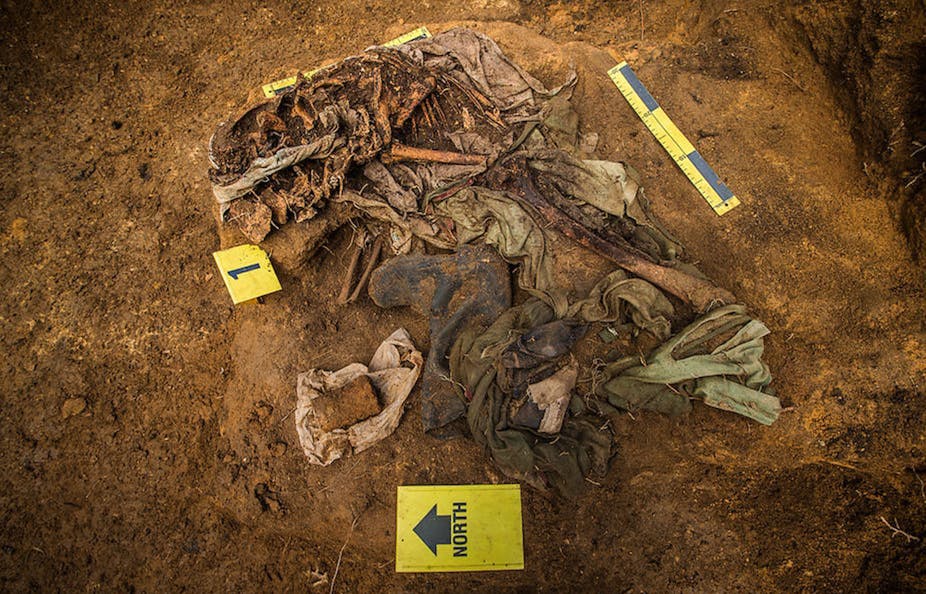I arrive in Buenos Aires in December. My fieldwork in Guatemala has ended and that in Argentina has not yet begun. I am in between things. I’ve been working with a team of forensic anthropologists exhuming mass graves and piecing together bones, labouring to identify victims of Guatemala’s recent history of political violence. After months of intimate proximity to death and terror, it is strange to arrive in the sunny cheer of Buenos Aires.
It’s high summer in Argentina, vacation time. I’m disoriented by the (to me) upside-down seasons of the Southern Hemisphere. I’m startled to find myself wandering the Palermo Soho neighbourhood, where tourists sip café cortados at sidewalk cafes. In leafy Parque Centenario, people practice yoga, folding themselves into the downward-dog position. I am a world away from Guatemala City with its barred windows and cautious streets. It is hard to believe that a few weeks ago I was standing in the mud of an excavation site in the remote province of Quiché, excavating bones.
In Guatemala, I was always with other people. We dug together and ate meals together. We shared rooms, clothes, mosquito spray, water bottles and colds. In Argentina, I am alone. My newly rented studio apartment is as bare and white as a clinic: white tiled floor, white walls, white curtains. In the bright summer light, I feel like I’m living inside an eggshell.
When do I realise I am not well? When I hear people laughing as they pass on the street and rush to close the curtains so they won’t glimpse me? When I skip dinner and sit hungry on the edge of my bed rather than go outside? Odd things enter my mind: a woodcut print I once saw of children in a garden. Above them, puffy summer clouds. Below them, roots of trees and plants sinking into the earth – and tangled among the roots, skeletons.
I constantly think of three men, how their bones were crisscrossed in the dirt. Why this exhumation and not one of the others? I don’t know, but this particular mass grave in the hills of El Quiché is always present, like a radio playing in the background. The strata of copper-tinged soil. The women from the community, arms folded, waiting at the edge of the excavation. The sound of the river and the pick axes.
200,000 dead and 45,000 disappeared
There are hundreds of mass graves in Guatemala. During the armed conflict from 1960 to 1996, the Guatemalan military, supported by the US government, targeted Maya farming communities for their supposed sympathy with leftist guerrilla groups. Entire villages were massacred. The United Nations estimates that 83% of the victims were indigenous Maya-speaking Guatemalans. The scale of the violence is staggering: in a country with a population of 8 million people, 200,000 were killed and 45,000 disappeared. El Quiché was at the epicentre of the bloodshed: locally, the conflict is known simply as La Violencia – the violence.
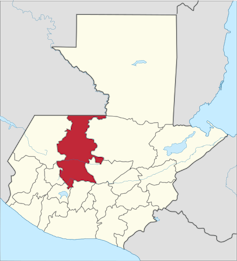
Standing in the exhumation site, we dig to find the buried bones. We uncover three male skeletons. Tidy bullet holes, entry and exit, mark two of the crania; the third skull is completely shattered. As we clean away the dirt, Maxi tells us to look for machete marks, which appear as lines etched across the bone. In other mass graves, on other skeletons, we have found the tell-tale hatch marks on skulls, scapula, fibula (a blow to sever the Achilles tendon, so people can’t run away). This is the kind of forensic detail we are being trained to spot and document. It can be used as evidence to prove torture and murder, to build a case for genocide in a trial. If there ever is a trial.
Toothbrushes, brooms, dustpans, pink and green plastic buckets. Maxi stopped at the Walmart outside of Guatemala City to buy supplies. The tools for exhuming mass graves are ordinary. We work for hours cleaning dirt off the three bodies, careful not to displace their position in the grave. It is not the bones I find most disturbing. It is not the skulls with their expression of grinning or screaming. It is not even the cord still tied around the intricate bones of one man’s wrists. It is the boots. All the local men wear these exact boots. When I look up from my work, I see these very boots gathered around the grave, worn by the men watching us, the men hoping to find their missing father, brother, son. After work, I scrape the mud from my shoes, using a stick, just as I use a stick to clean the mud from the soles of the dead men’s boots.

The three dead men are dressed in typical work clothes. As I brush the dirt off a plaid shirt, I can feel the sharp ribs beneath the fabric. I notice the even stitching of the homemade shirt. The fabric is intact and retains its colours. Some of the thread along the sleeve has rotted away (cotton degrades faster than nylon), leaving the fabric in pieces. I imagine the wives and mothers who cut and stitched the cloth.
Maxi tells me that when the bodies of women are found wearing traje (traditional dress), women from the community ask for photographs of their huipil, their handwoven blouses, and sometimes climb into the grave to inspect the stitching. The design of a huipil is unique and can give a clue to the identity of a skeleton. If a woman finds the body of her mother, she may have the same huipil made for herself and her daughters.
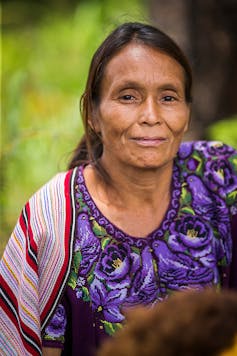
Recognition by huipil is not scientific identification. Bodies are also sometimes found with jewellery, visible tattoos and even legible identification documents. Such evidence is noted and forms part of a forensic profile. It can help establish identity, dependent on the findings of a forensic exam, and ideally, a DNA match. But identity documents can end up with someone other than their original owner. People have similar tattoos. Jewellery gets stolen. Clothes get switched.
Families and community members may find clothing more convincing than a forensic identification or even a DNA match. It can be hard to imagine a skeleton – or often just a fragment of bone – as a son or mother. A watch, a tattoo, a driver’s license – any of these may be more hospitable to the imaginative work entailed in accepting human remains as a missing loved one. (For more on the complications of associating bone fragments with missing people, see Renshaw, 2016 and Wagner, 2008.) Families and forensic teams sometimes measure evidence by different standards and find certainty in different forms of proof.
Locating the dead
In Guatemala, these different ways of knowing converge on dreams. In the Maya cosmovision, the dead play an active role in the lives of the living. Dreams are one of the principal channels of communication, a means by which ancestors offer counsel and give warning. From a young age, children are encouraged to remember and tell their dreams. (For more on dreams in Maya society, see Pérez-Sales and Navarro Garcia 2007; Tedlock, 1981; and Molesky-Poz, 2009. For children’s dream training, see Tedlock, 1981.) In the context of exhumations, community members report dreams in which the dead indicate where their body is located so that it can be found and given a proper burial. Without funeral rites, the dead are not at peace and cannot fulfil their communal role. (Pérez-Sales and Navarro-Garcia, 2007. For a well-documented discussion of communication between living and dead in the context of exhumation in East Timor, see Kinsella and Blau, 2013.) Exhumation helps restore the correct relationship between the living and the dead.
Community members seek to locate bodies through dreams, but the forensic team chooses where to excavate based on archaeological evidence. They look for subtle changes in the topography that may indicate a sunken area. They dig exploratory trenches looking for signs that the dirt is revuelto, the layers mixed together, which is an indication that it has been previous disturbed.
Dead bodies can’t drown
I want to know how these competing methods of locating bodies affect the relationship between teams and communities. I ask Zulma, who is the director of an organisation that provides practical and psychological support to communities during the process of exhumation. Zulma is a social worker who grew up in Quiché, wears the traje of her village, and speaks Ixil and Spanish. She acts as an interpreter, not only linguistically, but socially, between the local communities, the forensic team, and other NGOs and government actors. She tells me that for Maya communities, DNA is important and dreams are too. When I ask if she feels like the forensic teams takes the dreams reported to them seriously, she pauses and says, “We have to be patient with the scientists. They have a different way of seeing the world.” She adds, “more than anything, they are interested in the colour of soil, but we are interested in dreams.”
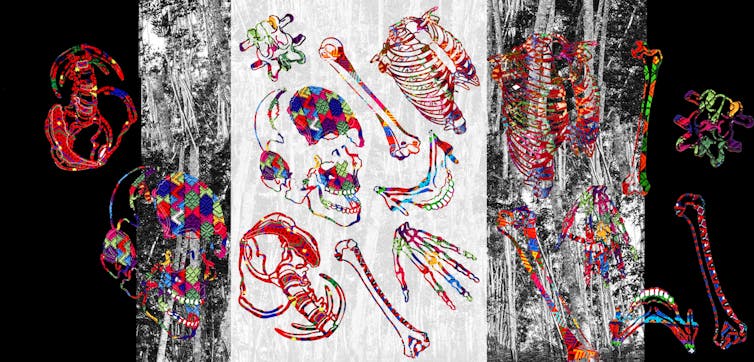
I ask Alvaro, a Spanish-speaking forensic archaeologist, what role dreams play in the team’s work. He says that just a week before, a woman approached him to relate a dream indicating that her father was buried under a big pine tree at the current site. I ask if the team will search there. He says, “We have to respect the way they see the world.” Then he sighs and says, “but there are a lot of pine trees!”
The site being excavated sits at the edge of a forest. We are digging by a large pine tree, whose thick roots make the shovelling hard going. It is already late in the day when we find the first bone. The air is heavy with approaching rain. As Alvaro scrapes away the earth from the femur, local men prepare a tarp to protect the site from the impending storm. In a flash of a machete blade they chop branches from trees, cutting supports and stakes cleverly notched to fit together. Maxi once said that one of the tragedies of La Violencia was that it disgraced the machete. It brought shame to a noble instrument that harvests maize and builds houses. So much death dealt by machetes, so many massacres. A tool of life made a weapon of death. The men at the site wield machetes with grace and magic, making tents over the open pits in minutes.
The rain begins to pour down, but the team keeps working under the tarp, fuelled by a buzz of excitement that we have found a grave. Within an hour, the distinct forms of three bodies are visible. They are skeletonized, meaning that all the flesh has decomposed and that only bone is left. There seem to be more bodies farther beneath. Alvaro guesses seven in total.
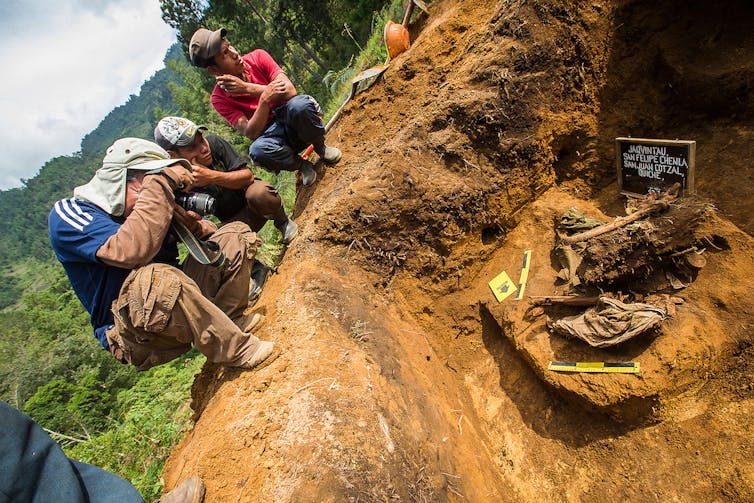
On the ride back to town, as the truck inches through the downpour, Maxi and Alvaro tell a story. During an exhumation in another community, a hard rain began to fall. The excavated pit with its half-exposed bodies quickly filled with water. Community members jumped in to save the people buried there from drowning. The punchline of this story is, of course, that dead bodies can’t drown.
A story about the dead drowning marks a boundary between the team and the families. It separates a biomedical conception of the corpse from an understanding of the dead as still in some sense vital. It divides science from the sacred. Such a boundary might seem unassailable, but the longer my fieldwork goes on, the less sure I am about the stability of such divisions. I begin to think that the boundary between scientific and non-scientific world-views is more like a porous membrane than a cement wall.
Not just dreams
It is not just dreams that unsettle the boundary between science and something else. It is also the potential liveliness of bones. In a lab, I see a forensic anthropologist stroke the forehead of a skull with tender touch and say, “poor guy,” as she records the trauma she reads in his bones. I notice a team member cringe when hammering a segment of femur to prepare a DNA sample. When I ask her about it, she says, “I hate doing it. It feels wrong. After everything they’ve been through.” A member of the Argentine forensic team remarks that she abhors the part of the lab protocol that requires her to place skulls in plastic bags. “It’s stupid but I feel like they’re suffocating.”
These are not strictly scientific reactions. The worry of suffocation is not so different than the worry of drowning. Tender touch, a visceral reluctance to break a bone or place a skull in a plastic bag imply a certain continued vitality to bones and a vulnerable personhood that persists in the dead. As Katharine Young has remarked about prohibitions against dark humour during autopsies, you can only offend a subject, not an object. So, too, it is subjects not objects who can be injured and cared for.
Perhaps “care” is the boundary that matters. It is not a boundary that divides scientific and non-scientific or families and forensic teams, it is one that encloses them in the same field. The field of care includes cleaning bones and examining the stitching of a huipil. It encompasses both dreams and DNA. As archaeologist Rosemary Joyce and human rights scholar Adam Rosenblatt have pointed out, forensic anthropologists are among the few groups of people socially sanctioned to care for dead bodies. Families and forensic teams share the duty of caring for the dead. It is the job of the living to save the dead from drowning.
The article on which this translation is based was published in collaboration with the blog of the journal Terrain. The illustrations and photos were kindly provided by the students of the Penninghen School and by the photographer Tristan Brand with the FAFG Fundacion de Antropologia Forense de Guatemala.


